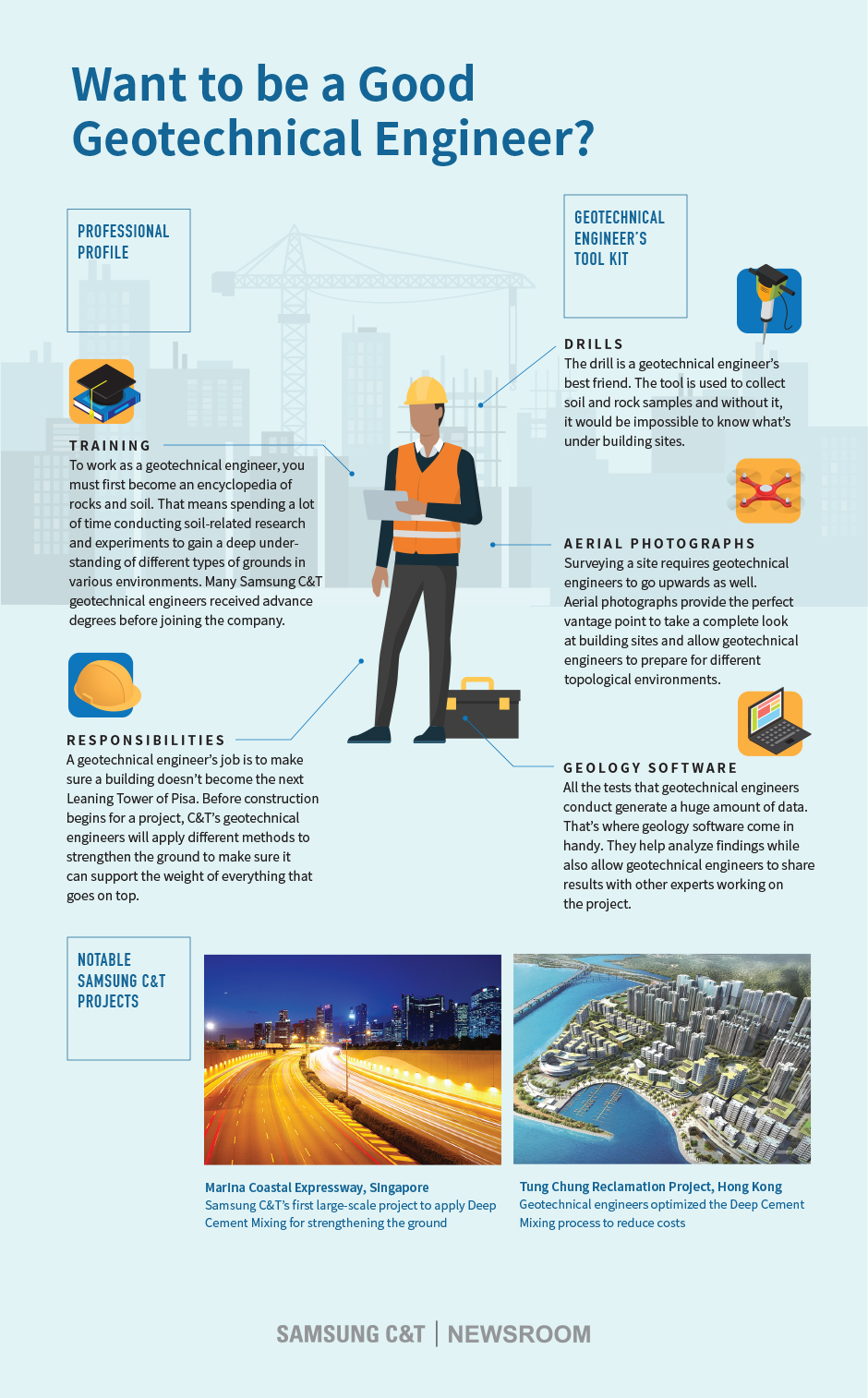The Only Guide for Geotheta
The Only Guide for Geotheta
Blog Article
What Does Geotheta Do?
Table of ContentsThe 6-Minute Rule for GeothetaThe 10-Second Trick For GeothetaFascination About GeothetaExcitement About GeothetaThe Best Strategy To Use For Geotheta

They perform site examinations, gather examples, carry out research laboratory tests, and assess data to evaluate the suitability of the ground for building tasks - Geo Tech Engineering. Based upon their findings, geotechnical engineers supply recommendations for foundation style, incline security, retaining frameworks, and reduction of geotechnical threats. They collaborate with other professionals, such as designers, architectural designers, and building and construction groups, to ensure that geotechnical factors to consider are incorporated into the general task style and execution
By analyzing the actions and residential properties of dirt and rock, they can identify potential geotechnical threats such as landslides, soil settlement, or incline instability. Their knowledge assists stop failures or accidents that might threaten lives and building. Here are some thorough tasks and duties of a geotechnical designer: Website Examination: Geotechnical designers conduct website investigations to collect data on subsurface conditions.
They interpret the information to comprehend the residential or commercial properties and behavior of the dirt and rock, including their strength, leaks in the structure, compaction qualities, and groundwater problems. Geotechnical Evaluation and Design: Geotechnical designers examine the data gathered throughout website investigations to assess the stability and suitability of the website for construction projects. They execute geotechnical calculations and modeling to assess variables such as birthing ability, negotiation, slope security, side earth pressures, and groundwater flow.
The Single Strategy To Use For Geotheta
Foundation Design: Geotechnical engineers play a crucial duty in making structures that can securely sustain the desired framework. They analyze the dirt problems and tons needs to determine the proper foundation type, such as shallow structures (e.g., footings), deep structures (e.g (https://www.tripadvisor.in/Profile/geotheta1)., heaps), or specialized techniques like soil enhancement. They take into consideration elements such as settlement restrictions, birthing capacity, and soil-structure communication to establish optimum structure designs
They assess building strategies, screen site tasks, and conduct area examinations to confirm that the style referrals are followed. If unexpected geotechnical problems emerge, they assess the circumstance and give suggestions for remediation or changes to the style. Risk Assessment and Reduction: Geotechnical engineers analyze geotechnical threats and risks connected with the project site, such as landslides, liquefaction, or dirt disintegration.

Partnership and Communication: Geotechnical designers work very closely with other specialists associated with a project, such as architects, structural designers, and building and construction teams. Efficient interaction and partnership are important to incorporate geotechnical factors to consider right into the total job style and building procedure. Geotechnical designers provide technological know-how, answer questions, and ensure that geotechnical demands are fulfilled.
The Definitive Guide to Geotheta
Right here are some sorts of geotechnical engineers: Foundation Engineer: Foundation designers focus on making and examining structures for frameworks. They analyze the soil conditions, lots needs, and website attributes to determine the most proper structure type and style, such as superficial structures, deep structures, or specialized strategies like stack foundations.
They examine the elements affecting slope security, such as dirt homes, groundwater problems, and incline geometry, and develop techniques to stop incline failures and minimize risks. Quake Engineer: Earthquake engineers concentrate on examining and creating structures to hold up against seismic forces. They analyze the seismic threat of a website, review dirt liquefaction capacity, and develop seismic style requirements to ensure the safety and durability of structures throughout quakes.
They execute field screening, collect samples, and analyze the gathered information to define the soil residential properties, geologic developments, and groundwater problems at a site. Geotechnical Instrumentation Designer: Geotechnical instrumentation designers concentrate on tracking and measuring the behavior of dirt, rock, and frameworks. They mount and preserve instrumentation systems that monitor aspects such as dirt settlement, groundwater levels, incline motions, and architectural variations to analyze performance and offer very early warnings of potential concerns.
How Geotheta can Save You Time, Stress, and Money.
They carry out tests such as triaxial tests, consolidation examinations, direct shear tests, and leaks in the structure examinations to gather data for geotechnical analysis and style. Geosynthetics Designer: Geosynthetics designers focus on the style and application of geosynthetic products, such as geotextiles, geogrids, and geomembranes. They make use of these products to boost soil stability, reinforce inclines, supply water drainage remedies, and control erosion.
They have a tendency to be investigative individuals, which suggests they're intellectual, introspective, and inquisitive. They wonder, methodical, sensible, logical, and logical. Several of them are likewise social, suggesting they're kind, charitable, participating, client, caring, handy, empathetic, skillful, and friendly. Does this audio like you? Take our free profession examination to discover if geotechnical designer is one of your leading career matches.
In the office atmosphere, geotechnical designers make use of specialized software program tools to perform calculations, create layouts, and analyze data. They prepare reports, evaluation job requirements, interact with clients and group members, and coordinate project activities. The office setting supplies a favorable environment for study, analysis, and collaboration with other experts entailed in the job.
The Greatest Guide To Geotheta
They regularly go to project sites to conduct website investigations, evaluate geotechnical conditions, and gather information for analysis. These check outs entail taking a trip to various areas, occasionally in remote or challenging surfaces. Geotechnical engineers may carry out soil sampling, conduct tests, and best site display building and construction activities to ensure that the geotechnical elements of the project are being applied appropriately.
Geotechnical designers likewise work in specialized geotechnical laboratories. In these centers, they perform experiments, carry out examinations on soil and rock examples, and assess the engineering homes of the products. Geotechnical laboratory designers function thoroughly in these atmospheres, dealing with screening equipment, operating instruments, and recording data. They team up with various other lab personnel to make sure accurate and trustworthy testing results.
Report this page